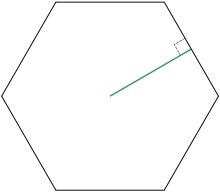Apothem

The apothem (sometimes abbreviated as apo[1]) of a regular polygon is a line segment from the center to the midpoint of one of its sides. Equivalently, it is the line drawn from the center of the polygon that is perpendicular to one of its sides. The word "apothem" can also refer to the length of that line segment. Regular polygons are the only polygons that have apothems. Because of this, all the apothems in a polygon will be congruent.
For a regular pyramid, which is a pyramid whose base is a regular polygon, the apothem is the slant height of a lateral face; that is, the shortest distance from apex to base on a given face. For a truncated regular pyramid (a regular pyramid with some of its peak removed by a plane parallel to the base), the apothem is the height of a trapezoidal lateral face.
For an equilateral triangle, the apothem is equivalent to the line segment from the midpoint of a side to any of the triangle's centers, since an equilateral triangle's centers coincide as a consequence of the definition.
Properties of apothems
The apothem a can be used to find the area of any regular n-sided polygon of side length s according to the following formula, which also states that the area is equal to the apothem multiplied by half the perimeter since ns = p.
This formula can be derived by partitioning the n-sided polygon into n congruent isosceles triangles, and then noting that the apothem is the height of each triangle, and that the area of a triangle equals half the base times the height.
An apothem of a regular polygon will always be a radius of the inscribed circle. It is also the minimum distance between any side of the polygon and its center.
This property can also be used to easily derive the formula for the area of a circle, because as the number of sides approaches infinity, the regular polygon's area approaches the area of the inscribed circle of radius r = a.
Finding the apothem
The apothem of a regular polygon can be found multiple ways.
The apothem a of a regular n-sided polygon with side length s, or circumradius R, can be found using the following formula:
The apothem can also be found by
These formulae can still be used even if only the perimeter p and the number of sides n are known because
See also
External links and references
- ↑ Shaneyfelt, Ted V. "德博士的 Notes About Circles, ज्य, & कोज्य: What in the world is a hacovercosine?". Hilo, Hawaii: University of Hawaii. Archived from the original on 2015-09-19. Retrieved 2015-11-08.
- Apothem of a regular polygon With interactive animation
- Apothem of pyramid or truncated pyramid
- Pegg, Jr., Ed. "Sagitta, Apothem, and Chord". The Wolfram Demonstrations Project.